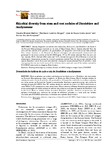Use este identificador para citar ou linkar para este item:
http://www.alice.cnptia.embrapa.br/alice/handle/doc/1015336Registro completo de metadados
| Campo DC | Valor | Idioma |
|---|---|---|
| dc.contributor.author | MARTINS, C. M. | pt_BR |
| dc.contributor.author | BORGES, W. L. | pt_BR |
| dc.contributor.author | COSTA JÚNIOR, J. de S. | pt_BR |
| dc.contributor.author | RUMJANEK, N. G. | pt_BR |
| dc.date.accessioned | 2015-05-13T11:11:11Z | pt_BR |
| dc.date.available | 2015-05-13T11:11:11Z | pt_BR |
| dc.date.created | 2015-05-13 | pt_BR |
| dc.date.issued | 2015 | pt_BR |
| dc.identifier.citation | Acta Scientiarum. Agronomy, Maringá, v. 37, n. 2, p. 163-170, Apr./June 2015. | pt_BR |
| dc.identifier.uri | http://www.alice.cnptia.embrapa.br/alice/handle/doc/1015336 | pt_BR |
| dc.description | Among the genera that exhibit stem nodulation, Aeschynomeneand Discolobiumare found in the Pantanal Mato-grossense (wetlands in the state ofMato Grosso, Brazil). Isolates obtained from the stem and root nodules of D. pulchellum, D. psoraleaefolium, D. leptophyllumand A. fluminensiswere collected from various locations in the Pantanal de Poconésub-region and phenotypically characterized and genotyped by restriction analysis of the 16S rDNA gene. Of the 282 isolates obtained from the stem and root nodules, 84.3% alkalized YMA media and 74.1% showed slow growth. No differences in either the phenotype or the genotype among the rhizobial populations isolated from the root or stem nodules of the species Discolobiumand A. fluminensis were observed. Among the isolates obtained from D. pulchellum,there was a group that was not similar to any of the reference strains used, and most of the isolates analyzed by PCR-RFLP were similar to the genus Bradyrhizobium. | pt_BR |
| dc.language.iso | eng | eng |
| dc.rights | openAccess | eng |
| dc.subject | Symbiose | pt_BR |
| dc.subject | Biological nitrogen fixation | pt_BR |
| dc.subject | Vegetable | pt_BR |
| dc.title | Rhizobial diversity from stem and root nodules of Discolobiumand Aeschynomene. | pt_BR |
| dc.type | Artigo de periódico | pt_BR |
| dc.date.updated | 2017-03-14T11:11:11Z | pt_BR |
| dc.subject.thesagro | Anatomia vegetal | pt_BR |
| dc.subject.thesagro | Nodulação | pt_BR |
| dc.subject.thesagro | Simbiose | pt_BR |
| dc.subject.thesagro | Fixação simbiótica de nitrogênio | pt_BR |
| dc.subject.thesagro | Legume | pt_BR |
| dc.subject.nalthesaurus | plant anatomy | pt_BR |
| dc.subject.nalthesaurus | nodulation | pt_BR |
| riaa.ainfo.id | 1015336 | pt_BR |
| riaa.ainfo.lastupdate | 2017-03-14 | pt_BR |
| dc.identifier.doi | https://doi.org/10.4025/actasciagron.v37i2.19565 | eng |
| dc.contributor.institution | CLAUDIA MIRANDA MARTINS, UNIVERSIDADE FEDERAL DO CEARÁ | pt_BR |
| dc.contributor.institution | WARDSSON LUSTRINO BORGES, CPAF-AP | eng |
| dc.contributor.institution | JOSÉ DE SOUZA COSTA JÚNIOR, EMPRESA DE ASSISTÊNCIA TÉCNICA E EXTENSÃO RURAL DO PARÁ | eng |
| dc.contributor.institution | NORMA GOUVEA RUMJANEK, CNPAB. | eng |
| Aparece nas coleções: | Artigo em periódico indexado (CPAF-AP)  | |
Arquivos associados a este item:
| Arquivo | Descrição | Tamanho | Formato | |
|---|---|---|---|---|
| CPAFAP2015Rhizobialdiversityfromstem.pdf | 751.79 kB | Adobe PDF |  Visualizar/Abrir |









